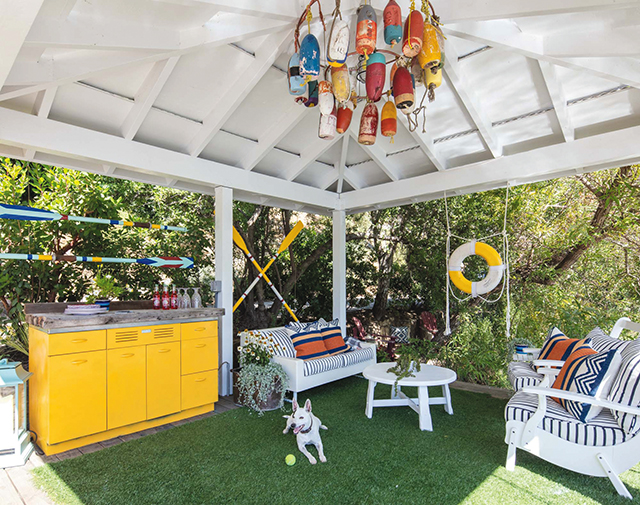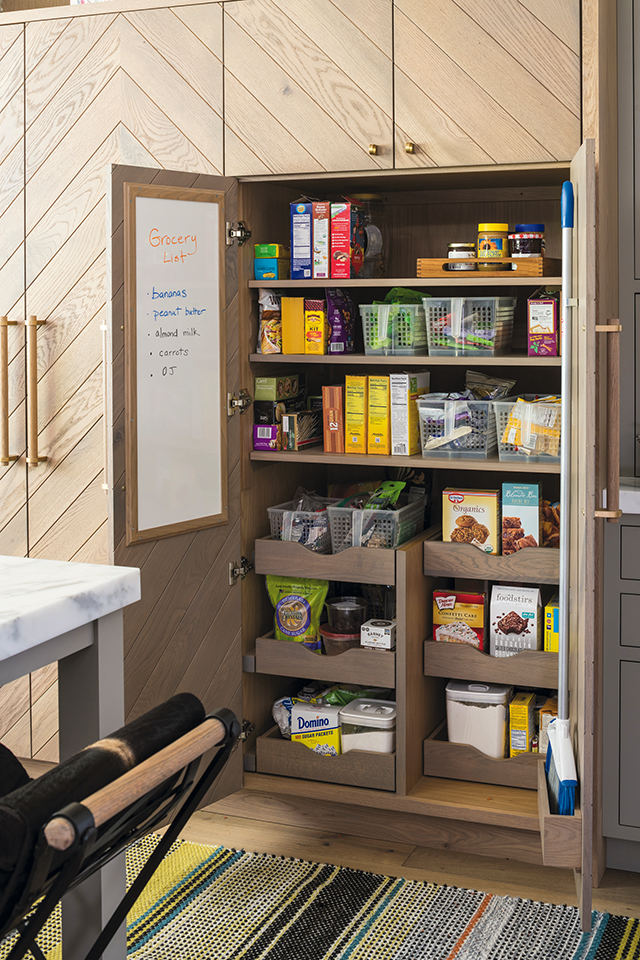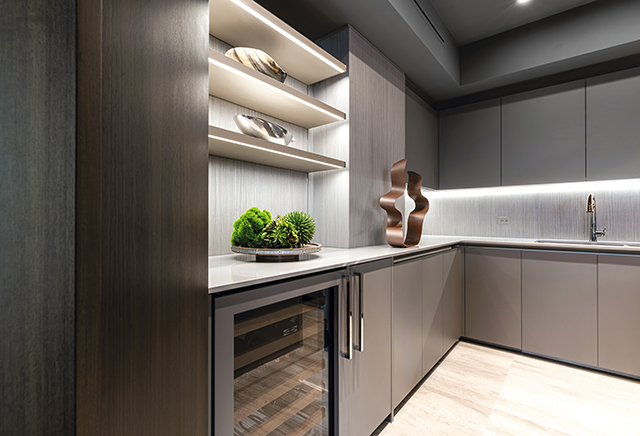Cabinets Deliver Clever Storage and Style
What are the hot trends in cabinetry this season? Where is it being used in new ways? What materials and finishes are you specifying? What hardware, features, configurations and technology are trending among your clients and in your region? Do you anticipate these trends continuing into the new year? Inquiring minds want to know! So here are the latest takes from across the country and industry:
National homebuilder Taylor Morrison’s National Design Director Lee Crowder;Marine Sargsyan, with online home products giant Houzz.com;National Kitchen & Bath Association’s Pamela McNally;Philadelphia area designer Liz Walton;Designer Shannon Ggem in Los Angeles;Minneapolis-based designer Lisa Peck.OVERVIEW
It’s no secret that our industry is booming, with strong consumer demand and ongoing shortages of skilled labor and products. Nonetheless, homeowners are still seeking to improve their spaces. Despite the challenges, everyone is surging forward and cabinetry has a significant slice of that activity.

Eye-popping color and outdoor cabinetry are both trending.
Photo: Shannon Ggem, Ggem Design // Mike P. Kelley (Photographer)
“Incorporating storage was an important aspect of homeowner’s renovation activities in 2020,” Sargsyan reports. Houzz’s 2021 study found that nearly one in five homeowners cited inadequate storage for enlarging their kitchens, she notes, and “More than half of all kitchen renovations included new cabinetry (57 percent).” Smaller kitchens included even a higher percent of cabinetry replacement (63 percent).
“Storage is one of the top three areas of consumer interest,” McNally agrees, noting that, “Reducing clutter, better organization, easy access all are driving this shift.” Some of this growth can definitely be attributed to the pandemic, especially as homeowners sought to reduce their shopping trips.
Hot Spots: “The pantry is becoming a very trendy place in the home to not only organize but maximize your storage, especially as bulk buying became more popular this past year,” declares Crowder. She notes the popularity of food storage organization. “It obviously starts with a great pantry.” Houzz also saw a surge in pantry upgrades, with nearly half of study respondents improving their cabinetry, an increase over 2020.

Flex rooms are definitely trending with new cabinetry needs. This includes laundry, pet and craft spaces. They’re also popular spots for bulk buying storage to enhance pantry capacity.
Home offices, garages and outdoor spaces have become hot spots for new cabinetry designs, too, because of the pandemic. Working from home, exercising, storing overflow items and escaping safely outdoors are all COVID-19-driven accelerations. “Many of our floor plans offer a mud locker or drop zone built in,” Crowder observes, “The more time you spend at home, you realize how important having a built-in space for those daily essential items at the entrance (usually from the garage) gives you peace of mind and [helps] everyone find what they need when it’s time to leave the house.”
Technology Trends: Smart home features are making their way into cabinetry as well. “Kitchens, baths and entire residential environments have been embracing fully integrated technology, and storage is a key area,” McNally says. The goals include accessibility, better visibility and security, the NKBA executive observes. “Smart home sensors help facilitate leak detection, temperature and lighting controls and are being designed into pantry areas, lower cabinets, shower enclosures, under sink drawers and under cabinets in kitchens. LED lighting is now a standard in virtually all cabinetry installs,” she reports, and the designers agree. Chargers are also being built into cabinetry to reduce clutter.
KITCHEN STORAGE TRENDS
The heart of the home has definitely gotten some transplant improvements. With pantries taking on more importance, sometimes beyond the kitchen, these areas are being freed up to serve more comfort roles.
Specialized Zones: NKBA’s study sees separate spaces for wine and coffee usage. Houzz sees dedicated areas for baking, snacks and beverages and homework. Among the specialty spots, pantries and wine bar storage have the greatest resonance in NKBA’s study. Kitchens are catering to personal preference and specialized zoning.
“We love to include coffee and wine stations with all the associated storage laid out for clients, like a mug drawer and fridge drawer for cream if they use it, or a pod drawer and a nearby wine fridge for bottles not yet being dispensed by the wine dispenser,” shares designer Ggem. Peck is seeing smoothie stations become a trend, along with coffee and beverage centers, and Walton says just about all of her kitchen projects have coffee/breakfast bars.

Comfort zones like wine and coffee centers are trending.
Photo: Eolo Design / NKBA
Configurations: “Our clients no longer want upper cabinets, preferring instead deep drawers with peg systems for plate and glass storage,” Ggem notes. Open shelves are still popular but used sparingly, as homeowners realize the dusting required to keep their contents clean, Walton points out. Peck sees narrow pullouts, as well as the general lack of wall cabinets and well-equipped bases and pantries. NKBA’s study cites large pull-out drawers with dividers.
Peck also sees an increase in secondary kitchen spaces, both as “back areas” for cleaning and storage, and auxiliary for older relatives to live independently with the family.
Styles and Finishes: Houzz has Shaker as the most popular style (57 percent), flat panel/slab at 21 percent and raised panel at 17 percent. In terms of finishes for the kitchen, Walton declares, “Wood tones are coming back in a big way! We are seeing a lot of warm walnut islands paired with soft white perimeter cabinets. Painted wood cabinets especially in navy or a powdery blue are very popular and pair well with white and warm wood tones.”
“Self-expression through color in cabinetry is definitely a trend,” Peck says. “We have done orange, yellow, blue and teal cabinetry in the spirit of this trend. We are also seeing a return to mixing painted cabinetry with wood. Rift cut white oak is a strong contender here in the Midwest. In modern kitchens we are seeing the use of acrylic slab door panels in gloss and ultra-matte finishes,” she adds.
Across the country, L.A. designer Ggem is seeing matte finishes and wood, including textured, fluted panels trending in materials. Taylor Morrison’s Crowder is seeing earthy hues along with warm neutrals and NKBA finds ash and rift cut oak solids and veneers trending, along with sophisticated high-pressure laminates.
One final note on finishes: “Wellness is huge in the kitchen conversation. Toxins and off gassing are no longer tolerated, and all clients inquire,” proclaims Ggem.
BATHROOM STORAGE TRENDS
The bathroom has also gotten enhancements. “Just like in kitchens, many people are having electrical outlets and charging stations built into their cabinets,” reports Taylor Morrison’s Crowder. “Another technology item popping up is cold storage,” she observes. “Adding a mini fridge into your cabinet bank allows you to store beauty items that require being cold – but they can also help keep creamers cold so you can make your coffee while getting ready in the bathroom.”
Configurations: Built-in vanities far outstripped freestanding in popularity, with floating styles trending upward, Houzz reports. “The floating vanity helps create visual space, making the vanity feel less heavy within the space,” Walton suggests.
Peck is seeing appliance garages migrate to her midwestern bathrooms, she says. They include chargers for hygiene and grooming tools and magnifying mirrors. She’s also seeing an emphasis on accessible cabinetry and nontoxic materials.
Taylor Morrison homebuyers like open shelves in their bathrooms, Crowder shares. They also want auto-opening and closing doors, outlets and charging stations.

Shaker is still a leading style trend for kitchens and bathrooms alike.
Photo: Caroline Sharpnack © Houzz
Styles and Finishes: Bathroom style trends track pretty close to kitchen, with Shaker, slab and raised panel in similar proportions. Walton sees natural wood tones like white oak and warm walnuts mixed with white or dark gray. Taylor Morrison is seeing light washed warm wood tones and textured woods in low maintenance matte finishes. The builder is also seeing painted looks, especially dark green, trending. Peck is seeing personalized colors, like teal and blues, along with rift cut woods, especially oak and walnut topping trends. Ggem sums up her clients’ preferences this way: “A minimal aesthetic is what is happening right now – slab doors, hidden pulls, quiet and clean.”
LAST WORDS
If your business is based on cabinetry manufacturing, distribution, installation or sales, this should be a strong season for you. It can also be a strong season for those who are “cabinetry adjacent,” like technology providers with a growing area of opportunity. Knowing and predicting the latest trends is essential to staying successful and a candy land full of fun and flair. 
Jamie Gold, CKD, CAPS, MCCWC is an author, wellness design consultant and industry speaker. Her third book, Wellness by Design (Simon & Schuster), published September 2020. You can learn more about her Wellness Market presentations, books, Wellness Wednesdays Clubhouse conversations and consulting services at jamiegold.net.
The post Cabinets Deliver Clever Storage and Style appeared first on Kitchen & Bath Design News.
Did you miss our previous article…
https://anekitchencabinets.com/?p=331
Adapting in a Changing Business Climate
Under normal circumstances, part of our job is to prepare plans for our clients to prime them for changes to their homes and lifestyles. Unfortunately, the pandemic crumbled remodeling hopes for many homeowners, and it had a serious effect on us as designers. First, we went from comfortably busy to zero in about two months. Then we were stagnant for almost a year. That dormancy was followed by a mind-boggling recovery, one that Eliot Sefrin, editor emeritus of KBDN, referred to as a “tectonic market shift.”
I survived the 2007-2009 recession and decided not to give in to the same negative feelings that plagued me until 2010. Instead, I used the pandemic downtime to work on my business, taking classes that had been on my bucket list for five years or more. At the same time, I read over 75 marketing books and white papers. It was not as gratifying as working with clients, but it was a major accomplishment.
Building, maintaining and marketing a unique brand reputation is challenging. There are excellent books and many courses to help us, but your choices need to be carefully considered. I learned the hard way during the recession and ended up wasting time and money on courses that didn’t work. During the pandemic, I avoided repeating the same mistakes.
Two exciting possibilities arose from free webinars recommended by acquaintances. Each marketing coach offered a new direction that sounded promising. One program is $3,500 and requires a commitment of at least six months. The other course costs over $10,000 and involves a year of classes. It’s easy to say “yes” to the compelling reasons the coaches present until we stop to think about our ROI. Curiosity helped me gain clarity to say “No” to the programs. Finally, I said “yes” to another customizable opportunity with great ROI possibilities.
NAVIGATING THE NEW NORMAL
Everyone is now adjusting to a new normal: higher remodeling investments and lower availability of labor and products. Homeowners are anxious to proceed with pandemic-delayed remodeling projects. Our 15-month business famine has become an overflowing feast.
In fact, home remodeling queries on Google went from 38% in March 2020 to 93% in March 2021. The annual Houzz survey verifies that home renovation spending increased 15% in the past year.
But will the trend continue or collapse?
Many variables will affect remodeling in the future, and all we can do as designers is perform our best every day, and stay on top of news reports about the economy, the pandemic and other fluid trends. Being prepared for change helps us cope with it. We can choose our course and correct it before a crisis happens by adapting to change.
The Harvard Business Review offered six tips about adapting to change: 1. Find humor in the situation; 2. Resist talking about your feelings; 3. Don’t stress out about stressing out; 4. Focus on your values instead of your fears; 5. Accept the past (and present) but fight for the future, and 6. Don’t expect stability.
COMPETING AND COMPARING
Competition is as fierce as ever in the design market, with more people entering our profession yearly. For example, 4,199 U.S. students graduated with interior design degrees in 2019. At that time, there were 77,900 interior designers in the nation. The average age of designers is 41 years. We’re all competing to build and maintain our brand reputation, make a living and grow our company (or the company that employs us).
I believe we do better when we compete against ourselves rather than competing against other people. Additionally, we do better when we don’t compare ourselves to others. But, admittedly, this is hard to do in today’s competitive world.
When I was attending design school, every assignment was necessary. I gave each one 115% of my effort, although I believed that others would receive a better grade. I wasn’t competing with them for a grade but rather comparing myself to them.
Before graduation, the faculty and students voted for one student to win the “Student Designer of the Year” award. I was shocked to win because, in my mind, everyone was more qualified than me. The woman who presented the award gave me fantastic advice: “Send press releases to the media.” That established my brand and my reputation, and it attracted clients and referral clients for years.
I continue to give at least 115% to everything I do. Clients’ goals become my goals. I’ve been fortunate to win design awards with this attitude. And while I don’t like to compare myself to other designers, it’s unavoidable. Marketing tools such as SEMRush, UberSuggest, BuzzFeed and Google Analytics provide helpful feedback by comparing me to competitors. It’s uncomfortable but necessary to gather and use this information that mainly relies on keywords we use. But, it’s just as important to not make it the focus of your work. We are each unique, and that should be celebrated!
GAINING THE EDGE
Prospective clients find us using specific keywords or phrases in Google, Bing or Yahoo. Search engines recommend us because we’ve used the same keywords or phrases in our websites, blogs and social media posts. Learning to use the right keywords is an art and a science. It challenges us to comply with specific secretive algorithms. Even Search Engine Optimization experts admit little knowledge about the data. Climbing to #1 of organic searches involves an investment of time and effort.
SEO is a broad subject that I’m still studying, a motivation to revise and write blogs with competitive terms. If your company can afford an SEO specialist, their fee will be $75-$150 per hour, which could add up to $1,500 a month (or more). You can also get monthly SEO services from companies like Fiverr for $14-$345 a month.
How do you know that you’re getting what you want?
Honestly, SEO isn’t a quick process and success isn’t guaranteed. Changes we make now may not show up in search engine results for four to six weeks or longer. To compete effectively, we have to know what keywords our competitors are using to help their ranking in the search engines. Finally, we have to compare ourselves to others who have: A well-known brand, an active website, an up-to-date blog and an active social media presence with good SEO use.
Competing with and comparing ourselves to others in our profession may be uncomfortable, but it’s necessary to adapt if we want to succeed. One of my favorite quotes rings true: “Success requires the ability to adapt. Only by being open to change will you have a true opportunity to get the most from your talent.” [Nolan Ryan] 
Diane Plesset, CMKBD, CAPS, NCIDQ is the principal of D.P. Design in Oregon City, OR and has over 35 years of experience as a kitchen and bath designer. She is the author of the award-winning book, THE Survival Guide: Home Remodeling, and has been the recipient of numerous design awards. Named a 2019 KBDN Innovator, Plesset has taught Western design to students of the Machida Academy in Japan and has a podcast, “Today’s Home.”
The post Adapting in a Changing Business Climate appeared first on Kitchen & Bath Design News.
Did you miss our previous article…
https://anekitchencabinets.com/?p=328
Re-Bath Parent Acquired by Private Equity Firm

PHOENIX — Home Brands Group Holdings Inc., the parent holding company of Re-Bath, the nation’s largest bathroom remodeling franchise, has been acquired by TZP Group LLC, a New York-based private equity firm, and a group of co-investors, the company announced. Financial details of the transaction were not disclosed.
“We are thrilled to partner with Re-Bath and its terrific management team, serving a group of committed franchisees across the U.S.,” said Vlad Gutin, a partner at TZP.
“Re-Bath complements our growing portfolio of leading consumer brands (and) we believe that Re-Bath’s unique, high-quality service offering, loyal customers, best-in-class products of leading brands and partnerships with premier, national retailers, coupled with TZP’s relationships and resources, can accelerate Re-Bath’s growth,” Gutin added.
Re-Bath, headquartered in Phoenix, operates more than 100 locations across North America, according to the company, which offers complete bathroom remodels, tub and shower updates, plus aging and accessibility solutions.
“We are excited to embark on our next chapter of growth with TZP’s investment representing a strong validation of the growth and success we’ve achieved and where we are headed,” said Re-Bath CEO, Brad Hillier. “Through this investment, we will be able to leverage TZP’s expertise and resources to further expand our brand to a wider audience and better serve our customers, franchisees, partners and employees.”
The post Re-Bath Parent Acquired by Private Equity Firm appeared first on Kitchen & Bath Design News.